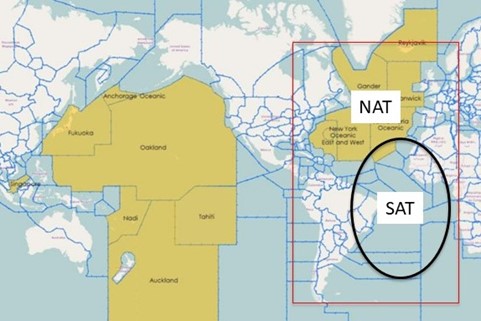PBCS
What is it?
It is navigation based on communication and surveillance performance. The PBCS concept applies specifications of required communication performance (RNP) and required surveillance performance (RSP), which assign criteria relating to the provision of ATS, including communications services, aircraft capacity and aircraft operator.
Purpose and technologies used
The PBCS provides objective operational criteria for evaluating different and emerging communications and surveillance technologies intended to advance air traffic management (ATM) operations. It also provides a framework in which all interested parties (regulators, air traffic service providers, operators, CSPs and manufacturers) continue to collaborate in optimizing the use of available airspace while identifying and mitigating risks to security.
The two main technologies are: controller-pilot data link communication (CPDLC) and automatic contract-dependent surveillance (ADS-C). CPDLC allows the exchange of text messages between the air traffic controller and the pilot, reducing voice load and increasing the clarity and accuracy of communication. ADS-C enables the automatic sending of aircraft position and intent information to the controller, improving situational awareness and coordination.
Requirements and advantages
To operate under PBCS, aircraft and operators must meet specific performance, equipment, procedure and authorization requirements. Performance requirements are defined in terms of RCP (Required Communication Performance) and RSP (Required Surveillance Performance), which indicate the level of reliability, availability, latency and integrity of communication and surveillance. Equipment requirements are defined in terms of RNP (Required Navigation Performance), which indicates the level of accuracy, integrity, continuity and functionality of the navigation system. Procedure and authorization requirements are defined by the competent authorities of each airspace and operator.
PBCS brings the following advantages to civil aviation:
- Allows reducing minimum separations between aircraft, increasing airspace capacity and optimizing routes;
- Allows you to increase the flexibility and adaptability of operations, allowing dynamic adjustments to weather conditions, traffic and user preferences;
- Allows you to reduce fuel consumption, pollutant emissions and operating costs, contributing to environmental and economic sustainability;
- Allows you to improve operational safety, reducing human errors, potential conflicts and collision risks.
PBCS implementation phase in the Atlantic Flight Information Region (FIR-AO)
The implementation of the PBCS concept in the FIR Atlântico is planned to take place by December 2025, and aims to increase the capacity of oceanic airspace under Brazilian jurisdiction and allow the safe reduction of minimum longitudinal and lateral separations between aircraft.
The PBCS operational plan in Brazil aims to achieve the following results:
- Reduced Separation Minimums: achieving a reduction in longitudinal (5 minutes or 30NM) and lateral (30NM) separation will allow the expansion of the offer of levels more adjusted to aircraft performance and increased airspace capacity;
- Separation compatible with the NAT region;
- Resource Savings: greater availability of optimal levels, which, in turn, will provide greater fluidity, greater fuel economy and consequently less environmental impact;
- Operational safety and comfort for passengers: Greater flexibility for changes in flight level for aircraft that suffer interference from the ITCZ (Intertropical Convergence Zone) and areas of turbulence; and
- Greater automation/alerts in the ATM: greater security, lower workload.
- EUR/SAM corridor: operation of aircraft with different performances, without the need for airspace segregation (hybrid operation);
Brazil expects a high degree of involvement in the PBCS venture from operators, the National Civil Aviation Agency – ANAC and CARSAMMA. It is now known that there are critical points for the project that must be resolved, such as the implementation of PBCS requirements in the SAGITARIO and SIGMA systems, guaranteeing the performance of the Data Link and defining the policy for local and regional monitoring. Although it is not yet known whether CARSAMMA will be the Agency responsible for monitoring PBCS airspace in the region, CARSAMMA is currently developing work related to the topic, with representatives integrating the following groups:
- SAT RMAs’ Harmonization and Standardizing RMA Procedures and Methodologies Project Team, approved at the SAT SOG 01 meeting, whose function is to support the principles of the Security Policy of the SAT region through the following objectives:
- Conduct a feasibility study consisting of a detailed analysis of the current state of data collection, processing and dissemination between the three RMAs (CARSAMMA, SATMA and ARMA), including all types of analysis (RVSM approval database, monitoring aircraft height, RVSM airspace audits, traffic data analysis, safety assessments, etc.);
- Identify differences in the current processes used by RMAs in the SAT REGIÃO and propose solutions to harmonize and standardize procedures when necessary;
- Evaluate the feasibility of implementing a centralized database of RMAs in the SAT region for collection and accessibility of LHDs, LLDs and LLEs;
- Adopt a standardized collision risk assessment methodology to ensure consistent and accurate risk assessment in the SAT region.

- Study Group on Airspace Planning (GEPEA), from DECEA, aimed at discussing improvement processes in the organization and management of Brazilian airspace. Within GEPEA, CARSAMMA participates in SG1/GADHOC FIR-AO, where we develop studies related to the model for analyzing lateral and longitudinal deviations carried out by RMAs that monitor air spaces where PBCS separations are used.



